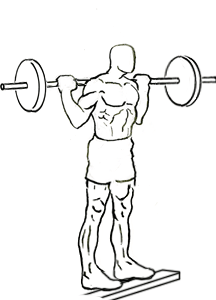Last Updated on September 30, 2022
The Standing Barbell Calf Raise is a staple exercise for building the muscles of your lower legs, specifically the calves. If you’re looking to develop strong, defined calves, this exercise is one of the most effective ways to achieve that goal. It targets both the gastrocnemius (the larger, outer portion of the calf muscle) and the soleus (the smaller, deeper muscle), giving you balanced calf development and a more sculpted appearance.
In this comprehensive guide, we’ll break down everything you need to know about the Standing Barbell Calf Raise, from the proper technique to the benefits, common mistakes to avoid, and even variations to spice up your calf training. Whether you’re new to strength training or an experienced athlete looking to refine your technique, this exercise is a must-have in your routine if you want to develop powerful, well-defined calves.
What is a Standing Barbell Calf Raise?
The Standing Barbell Calf Raise is a lower-body exercise that focuses on strengthening and toning the calf muscles. It’s typically performed with a barbell positioned on your back, which adds external resistance to the movement. The exercise is done in a standing position, which is ideal for targeting the gastrocnemius, the muscle that gives the calf its rounded shape.
The movement involves raising your heels off the ground, then lowering them back down, all while keeping your legs straight. This exercise can be done on a flat surface or with your feet elevated on a block or weight plates to increase the range of motion, thereby maximizing the stretch and contraction of the calf muscles.
The Importance of Calf Training
Calf training is often overlooked in lower-body workouts, but the calves play a crucial role in various physical activities. They are responsible for ankle stability, supporting body weight during movement, and generating power for activities like running, jumping, and sprinting.
Strong, well-developed calves can help improve overall athletic performance and reduce the risk of injury, especially in the Achilles tendon. Additionally, calf exercises like the Standing Barbell Calf Raise improve your balance and posture by strengthening the muscles that support your feet and ankles.
Benefits of the Standing Barbell Calf Raise
- Improved Lower Leg Strength
One of the primary benefits of the Standing Barbell Calf Raise is its ability to build strength in the calf muscles. The exercise targets the gastrocnemius and soleus, improving your ability to perform daily activities like walking, running, and jumping. Stronger calves contribute to greater overall lower body power and stamina, which can enhance your performance in sports and other physical activities.
- Better Muscle Definition
If you’re looking to sculpt your calves and achieve that sought-after definition, this exercise is a must. The standing version of the calf raise allows you to focus on the muscles at the top of your calves, enhancing both the size and definition of your calves. With consistent training, you’ll notice more muscle separation, shape, and definition in your lower legs.
- Increased Ankle Stability
The calf muscles play a significant role in ankle stability. By strengthening the calves, the Standing Barbell Calf Raise helps improve your balance and the stability of your ankles. This is crucial for activities such as sports, where quick movements and changes in direction are common. Strengthening your calves also helps prevent injuries like ankle sprains and strains.
- Improved Posture
Your calves are directly connected to your posture. Stronger calves help keep your posture in alignment by supporting the lower half of your body. A well-developed calf muscle can help balance the weight distribution between your upper and lower body, improving your overall stance and walking gait.
- Enhanced Performance in Other Lifts
While the Standing Barbell Calf Raise is a lower-body exercise, it can have a positive impact on other lifts. Strong calves contribute to better performance in exercises like squats, deadlifts, and lunges, where stability and lower-body power are key. By strengthening the muscles of the calves, you’re supporting better form and technique in these compound movements.
- Increased Flexibility and Mobility
The movement of raising and lowering your heels engages your Achilles tendon and stretches the muscles of the lower leg. This action helps increase flexibility and mobility in the ankle joint. Over time, this can reduce stiffness and improve your range of motion, which is beneficial not only for calf development but also for your overall functional movement.
Proper Technique for the Standing Barbell Calf Raise
Now that you know the benefits, let’s break down the step-by-step process for performing the Standing Barbell Calf Raise with proper form. Proper technique is key to maximizing the effectiveness of the exercise and minimizing the risk of injury.
Step 1: Set Up Your Barbell
Before starting, you need to ensure the proper setup of the barbell. Follow these steps:
- Position the Barbell on a Squat Rack:
Set up the barbell on a squat rack or a similar setup at shoulder height. Ensure the barbell is evenly loaded with weight plates that you can safely handle. Start with a manageable weight, especially if you are new to this exercise. - Stand Under the Barbell:
Step under the bar so that it rests across the upper part of your back, just below your shoulders. Ensure the barbell is centered and feels balanced on your back. - Grip the Barbell:
Grab the bar with both hands, using an overhand grip (palms facing forward). Your hands should be just outside shoulder-width. This grip will provide stability and help you maintain proper posture throughout the movement.
Step 2: Elevate Your Feet
Once you are positioned under the barbell, you need to elevate your feet to get the full benefit of the exercise.
- Place a Block or Plates Beneath Your Feet:
Set up a block, step, or two free weight plates on the floor, ensuring they are stable and won’t shift during the movement. Stand with the balls of your feet on top of the block or plates, with your heels hanging off the edge. This position allows for a greater stretch of the calf muscles and a deeper contraction at the top of the movement. - Position Your Feet:
Place your feet hip-width apart, with your toes pointing straight ahead or slightly outward. Ensure that your knees are not locked, and engage your core to stabilize your body. You should be standing tall with your chest lifted and your back straight.
Step 3: Lift Your Heels
Now that you’re in position, it’s time to perform the movement:
- Press Through the Balls of Your Feet:
Slowly and steadily, raise your heels as high as you can, lifting your body upward. Keep the movement controlled and focus on squeezing your calf muscles as you lift. Your legs should remain straight during the entire movement. - Focus on Full Range of Motion:
To maximize calf activation, ensure that you’re lifting your heels as high as possible. This full range of motion will help you achieve better muscle contraction and stretch.
Step 4: Lower Your Heels
Once you’ve reached the top of the movement, it’s time to lower your heels back down:
- Slowly Lower Your Heels:
Lower your heels back toward the floor in a slow and controlled manner. Allow your calves to stretch fully as your heels descend below the level of the block or plates. Feel the stretch in your calves as you go lower, but don’t let your heels touch the ground completely. Keep the movement fluid and controlled to maintain constant tension on the muscles. - Pause at the Bottom:
Pause for a moment at the bottom of the movement to fully stretch the calves before initiating the next rep. This pause increases the time under tension and can lead to more muscle growth.
Step 5: Return to the Starting Position
Once your heels have lowered as far as possible, return to the standing position by pressing through the balls of your feet and lifting your heels again. Complete the desired number of repetitions.
Repetition and Set Recommendations
To build strong calves, aim for 3-4 sets of 12-20 repetitions. Since the calf muscles are used to daily activities like walking and standing, they can often tolerate higher rep ranges. If you’re looking to increase strength, use a heavier load and perform fewer reps (e.g., 6-8). If your goal is muscle endurance or hypertrophy (muscle growth), higher reps with moderate weight are more effective.
Common Mistakes to Avoid
To get the most out of the Standing Barbell Calf Raise and avoid injury, here are a few common mistakes to watch out for:
- Using Too Much Weight:
While it can be tempting to load up the barbell with heavy weights, using too much weight can compromise your form. This can lead to a risk of injury, especially in your lower back or knees. Start with a manageable weight and focus on controlled, full-range movements. - Not Using a Full Range of Motion:
To properly target the calf muscles, ensure that you’re using a full range of motion. Don’t cut the movement short by failing to fully lower your heels or raise them high enough. The more range of motion you have, the better your calves will develop. - Relying Too Much on Momentum:
The Standing Barbell Calf Raise should be performed slowly and with control. Using momentum to bounce your heels up and down reduces the effectiveness of the exercise and can strain your muscles and joints. Focus on slow, deliberate movements to maximize the contraction and stretch of your calves. - Overarching the Lower Back:
Keep your back straight and avoid arching your lower back excessively. This can lead to lower back strain. Engage your core muscles to maintain proper posture throughout the exercise.
Variations of the Standing Barbell Calf Raise
While the standard Standing Barbell Calf Raise is highly effective, you can add variety to your calf training by incorporating these variations:
1. Seated Barbell Calf Raise
This variation targets the soleus more than the gastrocnemius. Instead of standing, sit on a bench with the barbell across your thighs. Perform the calf raise by raising and lowering your heels while your knees are bent.
2. Single-Leg Standing Barbell Calf Raise
Perform the calf raise with one leg at a time to focus on each calf individually. This variation helps improve any imbalances between your calves and provides a greater challenge for your muscles.
3. Smith Machine Barbell Calf Raise
If you’re training alone and want added stability, you can perform the calf raise using the Smith machine. The machine helps guide the barbell up and down, allowing you to focus on the movement without worrying about balancing the bar.
Conclusion
The Standing Barbell Calf Raise is a powerful exercise for building strength, definition, and overall lower leg functionality. By following the proper technique, focusing on a full range of motion, and avoiding common mistakes, you can maximize the benefits of this exercise and achieve stronger, more defined calves. Whether you’re training for aesthetics, performance, or injury prevention, this exercise should be a staple in your workout routine. So, grab a barbell, elevate your feet, and start working those calves!








